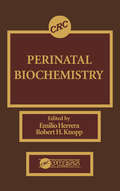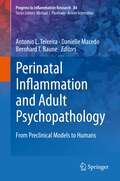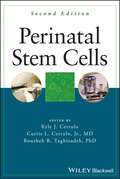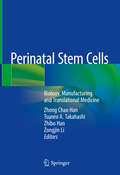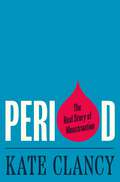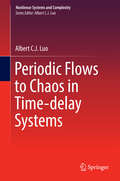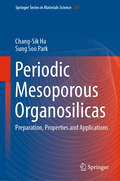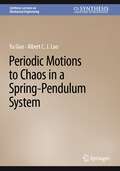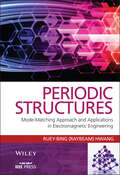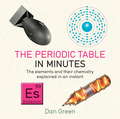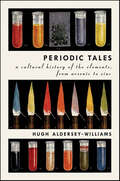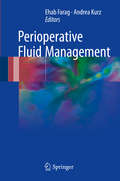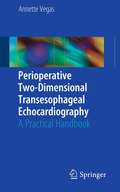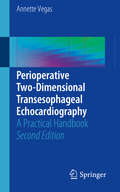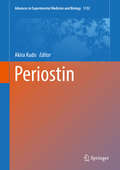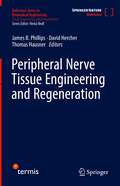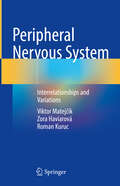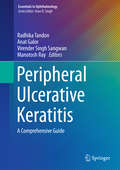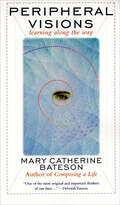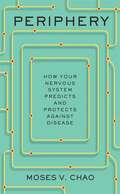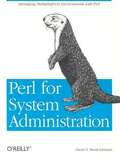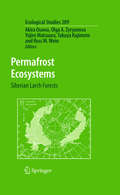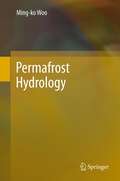- Table View
- List View
Perinatal Biochemistry
by Emilio Herrera Robert H. KnoppIntrauterine development and birth constitute an uninterrupted sequence of events that have a molecular physiologic background. Perinatal Biochemistry presents a comprehensive review of this subject. Specific topics addressed include maternal metabolism during pregnancy, maternal insulin resistance, embryonic and fetal metabolism and fuel consumption, the fetal pancreas, growth factors, brain metabolism, and biochemical adaptations to early extrauterine life. The book will be useful to biochemists and physiologists interested in perinatology; clinicians working in areas related to maternal health, gestational development, and delivery; gynecologists, neonatologists; pediatricians; endocrinologists; and internists.
Perinatal Inflammation and Adult Psychopathology: From Preclinical Models to Humans (Progress in Inflammation Research #84)
by Bernhard T. Baune Antonio L. Teixeira Danielle MacedoPerinatal psychiatry is an emerging field that investigates the role of perinatal events – for example pregnancy complications and infections – in the development of neuropsychiatric conditions, such as schizophrenia and mood disorders. Among the implicated pathological mechanisms, perinatal-induced inflammation seems to play a major role and is being considered as a potential target for therapeutic intervention. Bringing together various approaches in the field (preclinical and clinical, epidemiological, immunological and genetic methods), the book discusses the available evidence, the putative mechanisms and the challenges ahead.
Perinatal Stem Cells
by Rouzbeh R. Taghizadeh Kyle Cetrulo Curtis L. Cetrulo Jr.Perinatal Stem Cells, 2nd Edition builds on the first edition to provide an updated tutorial on perinatal stem cells, including stem cells harvested from the amniotic fluid, placenta, maternal blood supply, umbilical cord and Wharton's Jelly. As in the first edition, coverage includes the underlying biology of each of the sources of pregnancy related stem cells, cell culture, and potential therapeutic uses, as well as insights on the impact of these stem cells from obstetricians and gynecologists, cardiologists, hematologists, tissue engineers, and cord blood bankers.Normally discarded as medical waste, perinatal stem cells offer a powerful therapeutic tool box alternative to the controversial embryonic stem cells. Since publication of the first edition, a burgeoning commerical industry has developed around various sources of perinatal cells, and the second edition now includes an overview of this growing industry.With contributions from some of the top academic stem cell laboratories in the United States as well as new chapters from international stem cell scientists, Perinatal Stem Cells presents an update on the cutting-edge research in the field while maintaining its signature clinical focus.
Perinatal Stem Cells: Biology, Manufacturing and Translational Medicine
by Zongjin Li Zhong Chao Han Tsuneo A. Takahashi Zhibo HanThis book provides a comprehensive introduction to various types of perinatal stem cells. Given their unique regenerative abilities, stem cells offer a promising avenue in the treatment of degenerative diseases or injury. Currently, the limitations of postnatal cell sources and expanding efficiency may limit autologous stem cell therapies. Although embryonic stem cells (ESCs) and induced pluripotent stem cells (iPSCs) can be cultured indefinitely ex vivo, and can differentiate into three germ layers, ethical issues, the teratoma formation of ESCs and oncogenic risk of iPSCs are major obstacles to their clinical application. More recently, perinatal stem cells have been isolated from the umbilical cord, Wharton’s Jelly, placenta, amniotic membrane and amniotic fluid, which are normally discarded as medical waste. This book, after describing perinatal stem cells in detail, introduces readers to the various types of perinatal stem cells, addressing their characterization, banking, quality control and stability. Importantly, it also reviews the clinical applications of perinatal stem cells to therapy of diseases. Accordingly, it offers a valuable resource for clinicians, researchers and graduate students alike.
Period: The Real Story of Menstruation
by Kate ClancyA bold and revolutionary perspective on the science and cultural history of menstruationMenstruation is something half the world does for a week at a time, for months and years on end, yet it remains largely misunderstood. Scientists once thought of an individual&’s period as useless, and some doctors still believe it&’s unsafe for a menstruating person to swim in the ocean wearing a tampon. Period counters the false theories that have long defined the study of the uterus, exposing the eugenic history of gynecology while providing an intersectional feminist perspective on menstruation science.Blending interviews and personal experience with engaging stories from her own pioneering research, Kate Clancy challenges a host of myths and false assumptions. There is no such a thing as a &“normal&” menstrual cycle. In fact, menstrual cycles are incredibly variable and highly responsive to environmental and psychological stressors. Clancy takes up a host of timely issues surrounding menstruation, from bodily autonomy, menstrual hygiene, and the COVID-19 vaccine to the ways racism, sexism, and medical betrayal warp public perceptions of menstruation and erase it from public life.Offering a revelatory new perspective on one of the most captivating biological processes in the human body, Period will change the way you think about the past, present, and future of periods.
Periodic Flows to Chaos in Time-delay Systems
by Albert C. J. LuoThis book for the first time examines periodic motions to chaos in time-delay systems, which exist extensively in engineering. For a long time, the stability of time-delay systems at equilibrium has been of great interest from the Lyapunov theory-based methods, where one cannot achieve the ideal results. Thus, time-delay discretization in time-delay systems was used for the stability of these systems. In this volume, Dr. Luo presents an accurate method based on the finite Fourier series to determine periodic motions in nonlinear time-delay systems. The stability and bifurcation of periodic motions are determined by the time-delayed system of coefficients in the Fourier series and the method for nonlinear time-delay systems is equivalent to the Laplace transformation method for linear time-delay systems.
Periodic Mesoporous Organosilicas: Preparation, Properties and Applications (Springer Series in Materials Science #281)
by Chang-Sik Ha Sung Soo ParkThis book provides a comprehensive overview of the fundamental properties, preparation routes and applications of a novel class of organic–inorganic nanocomposites known as periodic mesoporous organosilicas (PMOs).Mesoporous silicas are amorphous inorganic materials which have silicon and oxygen atoms in their framework with pore size ranging from 2 to 50 nm. They can be synthesized from surfactants as templates for the polycondensation of various silicon sources such as tetraalkoxysilane. In general, mesoporous silica materials possess high surface areas, tunable pore diameters, high pore volumes and well uniformly organized porosity. The stable chemical property and the variable ability for chemical modification makes them ideal for many applications such as drug carrier, sensor, separation, catalyst, and adsorbent. Among such mesoporous silicas, in 1999, three groups in Canada, Germany, and Japan independently developed a novel class of organic–inorganic nanocomposites known as periodic mesoporous organosilicas (PMOs). The organic functional groups in the frameworks of these solids allow tuning of their surface properties and modification of the bulk properties of the material.The book discusses the properties of PMOs, their preparation, different functionalities and morphology, before going on to applications in fields such as catalysis, drug delivery, sensing, optics, electronic devices, environmental applications (gas sensing and gas adsorption), biomolecule adsorption and chromatography. The book provides fundamental understanding of PMOs and their advanced applications for general materials chemists and is an excellent guide to these promising novel materials for graduate students majoring in chemical engineering, chemistry, polymer science and materials science and engineering.
Periodic Motions to Chaos in a Spring-Pendulum System (Synthesis Lectures on Mechanical Engineering)
by Albert C. Luo Yu GuoThis book builds on the fundamental understandings, learned in undergraduate engineering and physics in principles of dynamics and control of mechanical systems. The design of real-world mechanical systems and devices becomes far more complex than the spring-pendulum system to which most engineers have been exposed. The authors provide one of the simplest models of nonlinear dynamical systems for learning complex nonlinear dynamical systems. The book addresses the complex challenges of the necessary modeling for the design of machines. The book addresses the methods to create a mechanical system with stable and unstable motions in environments influenced by an array of motion complexity including varied excitation frequencies ranging from periodic motions to chaos. Periodic motions to chaos, in a periodically forced nonlinear spring pendulum system, are presented through the discrete mapping method, and the corresponding stability and bifurcations of periodic motions on the bifurcation trees are presented. Developed semi-analytical solutions of periodical motions to chaos help the reader to understand complex nonlinear dynamical behaviors in nonlinear dynamical systems. Especially, one can use unstable motions rather than stable motions only.
Periodic Structures: Mode-Matching Approach and Applications in Electromagnetic Engineering (IEEE Press)
by Ruey-Bing HwangPERIODIC STRUCTURES Mode-Matching Approach and Applications in Electromagnetic Engineering In Periodic Structures, Hwang gives readers a comprehensive understanding of the underlying physics in meta-materials made of periodic structures, providing a rigorous and firm mathematical framework for analyzing their electromagnetic properties. The book presents scattering and guiding characteristics of periodic structures using the mode-matching approach and their applications in electromagnetic engineering. Provides an analytic approach to describing the wave propagation phenomena in photonic crystals and related periodic structures Covers guided and leaky mode propagation in periodic surroundings, from fundamentals to practical device applications Demonstrates formulation of the periodic system and applications to practical electromagnetic / optical devices, even further to artificial dielectrics Introduces the evolution of periodic structures and their applications in microwave, millimeter wave and THz Written by a high-impact author in electromagnetics and optics Contains mathematical derivations which can be applied directly to MATLAB® programs Solution Manual and MATLAB® computer codes available on Wiley Companion Website The book is primarily intended for graduate students in electronic engineering, optics, physics, and applied physics, or researchers working with periodic structures. Advanced undergraduates in EE, optics, applied physics applied math, and materials science who are interested in the underlying physics of meta-materials, will also be interested in this text.
Periodic Table in Minutes
by Dan GreenAn icon of science, the Periodic Table defines the fundamental chemistry of everything in the universe. In this compact yet comprehensive guide, Dan Green outlines the history, development and workings of the table, shows how its design reflects and illuminates the organisation of all matter, and even explains what it has to tell us about the chemistry of distant stars and of our own bodies. Contents include an individual entry for every known element - detailing properties, uses and key data - and sections on the patterns and groups of the famous table, as well as explanations of basic chemistry concepts such as elements and compounds, atomic structure, chemical bonds, reactions and radioactivity, amongst many others.
Periodic Table in Minutes (IN MINUTES)
by Dan GreenAn icon of science, the Periodic Table defines the fundamental chemistry of everything in the universe. In this compact yet comprehensive guide, Dan Green outlines the history, development and workings of the table, shows how its design reflects and illuminates the organisation of all matter, and even explains what it has to tell us about the chemistry of distant stars and of our own bodies. Contents include an individual entry for every known element - detailing properties, uses and key data - and sections on the patterns and groups of the famous table, as well as explanations of basic chemistry concepts such as elements and compounds, atomic structure, chemical bonds, reactions and radioactivity, amongst many others.
Periodic Tales: A Cultural History of the Elements, from Arsenic to Zinc
by Hugh Aldersey-WilliamsIn the spirit of A Short History of Nearly Everything comes Periodic Tales. Award-winning science writer Hugh Andersey-Williams offers readers a captivating look at the elements—and the amazing, little-known stories behind their discoveries. Periodic Tales is an energetic and wide-ranging book of innovations and innovators, of superstition and science and the myriad ways the chemical elements are woven into our culture, history, and language. It will delight readers of Genome, Einstein’s Dreams, Longitude, and The Age of Wonder.
Perioperative Fluid Management
by Ehab Farag Andrea KurzThis book presents the most recent evidence-based facts on perioperative fluid management and discusses fluid management from basic sciences to clinical applications and the patients' outcomes. Recent advances in understanding the Revised Starling principle with new concepts in tissue perfusion and the most recent techniques of perioperative goal directed fluid management are described. The endothelial glycocalyx functions and the influence of fluid management on its integrity are covered in detail; moreover, the techniques for its protection are also discussed. The dilemma of perioperative use of hydroxyethyl starch solutions and the resurgence of interest in using human albumin as an alternative colloid is explored. The problems of using unbuffered solutions during the perioperative period and comparison between restrictive versus liberal fluid management are discussed in full. Perioperative Fluid Management will be of interest to anesthesiologists and also intensivists.
Perioperative Two-Dimensional Transesophageal Echocardiography
by Annette VegasTransesophageal echocardiography (TEE) is a valuable diagnostic modality now routinely used during cardiac surgery and in the intensive care unit. Increasingly, anesthesiologists trained in TEE provide the service in both settings where they face the challenge of integrating numerous current TEE guidelines into day-to-day practice. Perioperative Two-Dimensional Transesophageal Echocardiography: A Practical Handbook has been designed to be a concise, portable guide for using TEE to recognize cardiac pathology during the perioperative period. This compact guide has a diverse appeal for anesthesiologists, cardiac surgeons, and cardiologists desiring comprehensive up-to-date echocardiographic information at their fingertips. Features More than 450 full-color, high quality clinical images and illustrationsSynopsis of cardiac pathology commonly encountered in cardiac surgery patientsConvenient spiral bindingOn-the-spot reference for echocardiographers with a wide range of experience, from novice to expert
Perioperative Two-Dimensional Transesophageal Echocardiography: A Practical Handbook
by Annette VegasTransesophageal echocardiography (TEE) is a valuable diagnostic modality now routinely used during cardiac surgery and in the intensive care unit. Increasingly, anesthesiologists, cardiologists and critical care physicians trained in TEE provide the service in both settings where they face the challenge of integrating numerous current TEE guidelines into day-to-day practice. Perioperative Two-Dimensional Transesophageal Echocardiography: A Practical Handbook, 2nd Edition has been designed to be a concise, portable guide for using TEE to recognize cardiac pathology during the perioperative period. This compact guide has a diverse appeal for anesthesiologists, cardiac surgeons and cardiologists desiring comprehensive up-to-date echocardiographic information at their fingertips.Features Updated to include 4 new chapters Now contains more than 600 full-color, high quality clinical images and illustrations Includes the most recent guidelines Retains a compact format that highlights key information Synopsis of cardiac pathology commonly encountered in cardiac surgery patients On-the-spot reference for echocardiographers with a wide range from novice to expert experience
Periostin (Advances in Experimental Medicine and Biology #1132)
by Akira KudoThis book provides a comprehensive and up-to-date review of current understanding of periostin and its importance for human health and disease. Periostin is a secretory matricellular protein that has been revealed to play key roles in fibrillogenesis and cell migration, including metastasis of cancer cells. The production of periostin is upregulated during fibrotic responses and the mechanisms by which it promotes fibrosis have become a focus of interest owing to the potential clinical benefit to be derived from periostin blockade. In this book, readers will find coverage of all aspects, from the basic properties of periostin and its function as a scaffold for assembly of extracellular proteins through to its roles in bone and tissue regeneration, tumorigenesis, myocardial infarction, inflammatory and immune system disorders, and other diseases. Readers will also find the latest information on functions of periostin related to stemness and the application of periostin as a biomarker. It is hoped that the detailed knowledge of periostin and its pathobiological significance provided in this book will aid in the search for effective treatments for currently incurable diseases.
Peripheral Nerve Sheath Tumors: From Preclinical Studies to Advanced Therapies
by Ignazio Gaspare Vetrano Vittoria NazziThis book offers an update about peripheral nerve sheath tumors (PNST), both in their benign and malignant forms (MPNST). Starting from the most innovative preclinical studies about genetic and omics characterization, it then explores the traditional and advanced imaging modalities (ultrasound, DTI, etc) and the electrophysiological assessment. Another relevant part is reserved to the description of the most recent surgical techniques (fluorescent dye for intraoperative surgical guidance, neurophysiological monitoring, esoscopic view). Finally, new oral treatment for PNST related to neurocutaneous diseases (as selumetinib in plexiform neurofibromas) is described. Written by worldwide experts in each specifical field, if offers a multidisciplinary vision to PNST, approaching the topic in a translational way, from preclinical studies to the current medical practice. The ideal readers are all health operators involved in the treatment of these tumors- from neurosurgeons to radiologists, neurologists, geneticists, biologists, etc) as well as medical students in these disciplines.
Peripheral Nerve Tissue Engineering and Regeneration (Reference Series in Biomedical Engineering)
by James B. Phillips David Hercher Thomas HausnerThis updatable book provides an accessible informative overview of the current state of the art in nerve repair research.The introduction includes history of nerve repair research and establishes key concepts and terminology and will be followed by sections that represent the main areas of interest in the field: (1) Biomaterials, (2) Therapeutic Cells, (3) Drug, Gene and Extracellular Vesicle Therapies, (4) Research Models and (5) Clinical Translation. Each section will contain 3 - 6 chapters, capturing the full breadth of relevant technology. Bringing together diverse disciplines under one overarching theme echoes the multidisciplinary approach that underpins modern tissue engineering and regenerative medicine. Each chapter will be written in an accessible manner that will facilitate interest and understanding, providing a comprehensive single reference source. The updatable nature of the work will ensure that it can evolve to accommodate future changes and new technologies. The main readership for this work will be researchers and clinicians based in academic, industrial and healthcare settings all over the world.
Peripheral Nervous System: Interrelationships and Variations
by Viktor Matejčík Zora Haviarová Roman KurucThis book comprehensively evaluates the morphological and clinical aspects of the peripheral nervous system and its involvement in various pathologies. It thoroughly describes its topography, morphology, its peculiarities - that are missing in anatomical and surgical textbooks- and their possible influence on the clinical picture. Their preoperative diagnosis is difficult, even impossible. Figures and line drawings enrich the view of structures that so far. have only been partially documented. The authors' descriptions are based on clinical observations and systematic work on the 246 human bodies of healthy people who died a sudden or violent death (most often in car accidents). Dissection is the most precise method to elucidate the range of variability, which is often largely responsible for the failure of surgical treatments. Their recognition can minimize damage to nerve structures, and the acquired knowledge can help clarify clinical signs and symptoms in surgery or internal medicine. The data presented in this publication will however be useful for traumatologists, orthopedists, spinal surgeons, neurosurgeons, plastic surgeons, as well as neurologists and neurophysiologists, and to all those who are dealing with or are interested in this field.
Peripheral Ulcerative Keratitis
by Radhika Tandon Anat Galor Virender Singh Sangwan Manotosh RayA handy manual for cornea specialists, this book provides detailed practical information about a complex, sight-threatening disease that can be challenging to diagnose and manage. This text features chapters dedicated to outlining all facets of diagnosis and management while covering both medical and surgical treatment options. Peripheral Ulcerative Keratitis, supplemented with useful references and appendices to provide simple step by step algorithms, is written by internationally renowned authors who are experts in the field. Including practical tips and guidelines for diagnosis and therapy of these disorders, Peripheral Ulcerative Keratitis is designed to serve as a guide for comprehensive ophthalmologists and should find itself on the bookshelves of ophthalmology clinics, corneal practices and training programs across the country.
Peripheral Visions: Learning Along the Way
by Mary C. BatesonMary Catherine Bateson, author of Composing a Life, is our guide on a fascinating intellectual exploration of lifetime learning from experience and encountering the unfamiliar. Peripheral Visions begins with a sacrifice in a Persian garden, moving on to a Philippine village and then to the Sinai desert, and concludes with a description of a tour bus full of Tibetan monks. Bateson's reflections bring theses narratives homes, proposing surprising new vision of our own diverse and changing society and offering us the courage to participate even as we are still learning.
Periphery: How Your Nervous System Predicts and Protects against Disease
by Moses V. ChaoA leading neuroscientist argues that the peripheral nervous system, long understood to play a key role in regulating basic bodily functions, also signals the onset of illness.The central nervous system, consisting of the brain and the spinal cord, has long been considered the command center of the body. Yet outside the central nervous system, an elaborate network of nerve cells and fibers extends throughout our bodies, transmitting messages between the brain and other organs. The peripheral nervous system, as it’s known, regulates such vital functions as heart rate, digestion, and perspiration and enables us to experience the barrage of sounds, tastes, smells, and other sensory information that surrounds us. But beyond these crucial roles, the peripheral nervous system might do even more: it might warn us of diseases in our future.As Moses Chao argues in Periphery, from Parkinson’s disease to autism to dementia, many neurological conditions emerge not in the brain but rather within the peripheral nervous system, in the dense network of nerves that wrap around the gastrointestinal tract. What’s more, dysfunctions of the peripheral nervous system can signal the onset of disease decades before symptoms like tremor or memory loss occur. Fortunately, unlike nerves in the brain and spinal cord, peripheral nerves can heal and regenerate in response to injury and aging. The therapeutic implications are remarkable. Chao shows how, with a better understanding of the peripheral nervous system, we could not only predict and treat neurological diseases long before their onset, but possibly prevent them altogether.Full of new ideas and bold interpretations of the latest data, Periphery opens exciting avenues for medical research while deepening our understanding of a crucial yet underappreciated biological system.
Perl for System Administration
by David N. Blank-EdelmanPerl for System Administrationis for anyone who needs to use Perl for administrative tasks and needs to hit the ground running.
Permafrost Ecosystems
by Akira Osawa Olga A. Zyryanova Takuya Kajimoto Yojiro Matsuura Ross W. WeinDrawing from a decade-long collaboration between Japan and Russia, this important volume presents the first major synthesis of current knowledge on the ecophysiology of the coniferous forests growing on permafrost at high latitudes. It presents ecological data for a region long inaccessible to most scientists, and raises important questions about the global carbon balance as these systems are affected by the changing climate. Making up around 20% of the entire boreal forests of the northern hemisphere, these 'permafrost forest ecosystems' are subject to particular constraints in terms of temperature, nutrient availability, and root space, creating exceptional ecosystem characteristics not known elsewhere. This authoritative text explores their diversity, structure, dynamics and physiology. It provides a comparison of these forests in relation to boreal forests elsewhere, and concludes with an assessment of the potential responses of this unique biome to climate change. The book will be invaluable to advanced students and researchers interested in boreal vegetation, forest ecology, silviculture and forest soils, as well as to researchers into climate change and the global carbon balance.
Permafrost Hydrology
by Ming-Ko WooPermafrost Hydrology systematically elucidates the roles of seasonally and perennially frozen ground on the distribution, storage and flow of water. Cold regions of the World are subject to mounting development which significantly affects the physical environment. Climate change, natural or human-induced, reinforces the impacts. Knowledge of surface and ground water processes operating in permafrost terrain is fundamental to planning, management and conservation. This book is an indispensable reference for libraries and researchers, an information source for practitioners, and a valuable text for training the next generations of cold region scientists and engineers.
